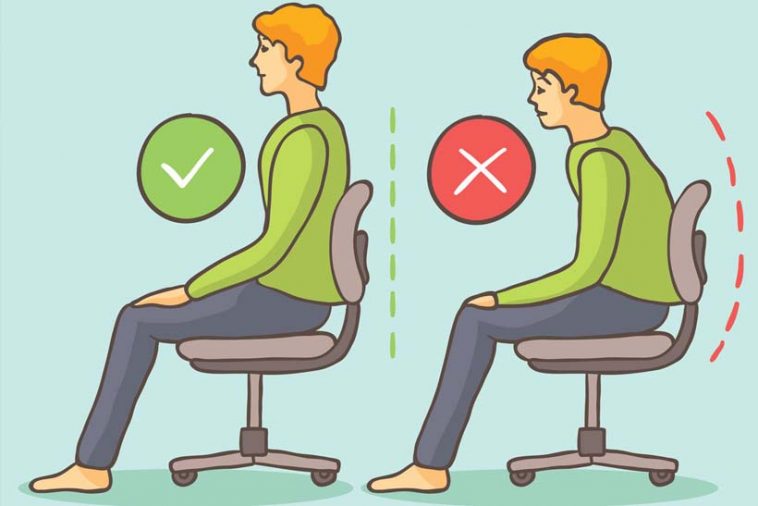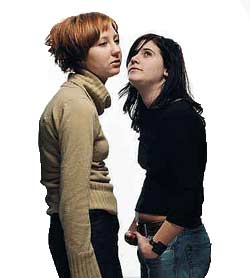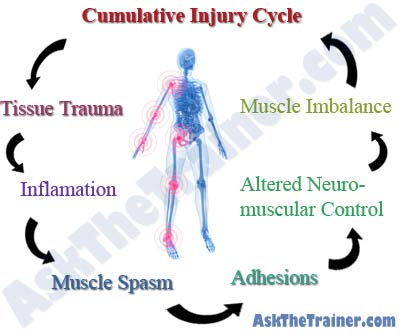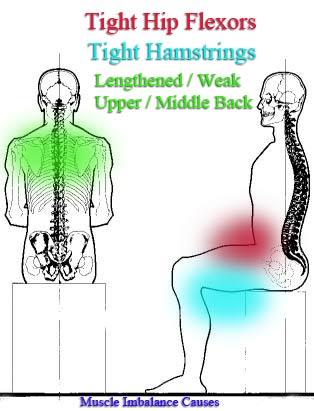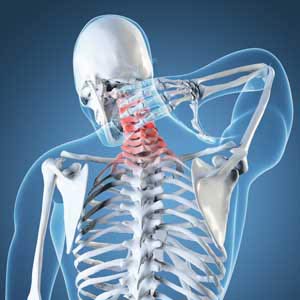- Like
- SHARE
- Digg
- Del
- Tumblr
- VKontakte
- Flattr
- Buffer
- Love This
- Save
- Odnoklassniki
- Meneame
- Blogger
- Amazon
- Yahoo Mail
- Gmail
- AOL
- Newsvine
- HackerNews
- Evernote
- MySpace
- Mail.ru
- Viadeo
- Line
- Comments
- Yummly
- SMS
- Viber
- Telegram
- JOIN
- Skype
- Facebook Messenger
- Kakao
- LiveJournal
- Yammer
- Edgar
- Fintel
- Mix
- Instapaper
- Copy Link
Have years of working a desk job taken a toll on your posture? Want to know the benefits of good posture and how to fix your bad posture?
Start here… ?
? First… You Need to Know About Two Types of Posture
To understand postural alignment and fix your posture, you first need to know the difference between two types of posture.
Let’s learn about those now… ?
? Static Posture
When someone mentions posture, you probably immediately think of static posture. Static posture is the alignment of your body while you are still.
More importantly, static posture refers to the length-tension relationships of your muscles and the corresponding alignment of your joints.
You may first notice posture problems when you or someone else observes obvious issues with your static posture.
? Dynamic Posture
Dynamic posture is the alignment of your body during movement. The length-tension relationships between working and opposing muscles are especially important to dynamic posture.
Poor dynamic posture can influence static posture and vice versa. Since many exercises are repetitive movements, it is important to keep your dynamic posture in mind.
? Posture Problems You May Not Know About Can Lead to Injury
If you have imbalanced length-tension relationships and improper dynamic posture during movement, the constant tug-of-war between muscles can prematurely age your joints and possibly lead to muscle, joint, tendon, and ligament injuries.
These types of muscle imbalances are called postural distortion patterns. ☝️
There are many problems associated with poor posture which have negative long-term effects on your body and health. These problems with your posture will not only impact how you feel, but how your body looks.
? If you continue to exercise with poor posture, you will recruit the wrong muscles and build your body disproportionately.
Physical therapists fix problems after injuries happen, some of which are due to posture problems, but they also work with clients to prevent injury by correcting postural problems before they lead to injuries in the first place.
On the other hand, orthopedic surgeons physically repair any musculoskeletal overuse or traumatic injuries, some which are also due to posture problems.
Finally, personal trainers take a preventative and corrective stance to fix your posture problems before they lead to injury.
?♂️ What Causes the Common Posture Problems?
Muscle Imbalances Due Sedentary Lifestyles are a Primary Cause of Posture Problems
The cumulative injury cycle illustrates how muscle imbalances originate.
First, there is a trauma, which can result from repetitive motion with poor dynamic posture or poor static posture.
This trauma causes inflammation, causing your muscles to spasm and develop knots or adhesions.
The adhesions decrease the functionality of your muscles, which your brain cannot control properly. The inability of your nervous system to maintain proper postural alignment causes muscle imbalances.
If you do not correct your muscular imbalances the cycle will repeat over and over again and get progressively worse.
? If You Ask Professionals from Different Fields, You May Get Different Answers
- A chiropractor may tell you that your spine is out of alignment and that causes posture problems.
- A podiatrist (foot doctor) may tell you your whole body is out of alignment because of a ill-fitting pair of shoes or flat feet. They may recommend comfortable canvas sneakers for better foot health.
- A psychologist may even tell you that your bad posture is due to depression.
My point is that there are many different ways to look at posture problems, and there may be many ways to solve them.
You don’t have to be a personal trainer, doctor, or physical therapist to see that muscle imbalances are likely the cause of your bad posture.
? What are Some Common Specific Muscle Imbalances?
The most common muscle imbalances are caused by a sedentary lifestyle. When you are seated for a large percentage of time, you can develop a characteristic pattern of certain muscles becoming tight or shortened.
If a muscle sits in a shortened position for a prolonged period if time, it will become tight, which really means it will become shorter than it is meant to be.
When a muscle is shorter than the optimal length, it not only affects the opposing muscle, but can have repercussions on the entire musculoskeletal system. Here are some common muscles which cause the most posture problems.
? Tight Hip Flexors

Tight hip flexors are a major cause of many posture problems. The human body is meant to be upright most of the time, not seated in a computer chair or on the couch.
When subjected to long hours in a seated position, the hip flexors become shortened. When the hip flexors are shortened, they cause the pelvis to rotate anteriorly, or tilt downward in front.
You can easily see the repercussions of anterior pelvic tilt on skeletal alignment. The lumbar spine becomes excessively arched and the thoracic spine develops a kyphotic (rounded/hunch back) alignment. Forward head posture can be another downstream result of anterior pelvic tilt.
Tight hip flexors can take over the work meant for the abdominal muscles, making it almost impossible to get benefit from many abdominal exercises.
Tight hip flexors cause the primary hip extensor, the gluteus maximus, to become lengthened and weak. This is because of the agonist-antagonist relationship between the glutes and hip flexors.
When the primary hip extensors become weak the synergist (helper) muscle also takes over, causing further problems. In this case, the hamstrings may take over work intended for the glutes, and become injured due to excessive strain.
? Tight Hamstrings
You can probably feel the difference in length of your hamstrings when you sit down. When you stand, the muscles are lengthened. Sitting even with good posture (above) shortens your hamstrings. If you sit for prolonged periods of time, you will be prone to chronic hamstring tightness.
There are a few posture problems associated with tight hamstrings. If the hip flexors (above) are tight, the glutes will weaken and the hamstrings will become your primary hip extensor. The hamstrings are supposed to be the synergist, but become the prime mover. This is called synergistic dominance, and it increases the chances of injury.
It is easy to see why synergistic dominance increases the chances of injury. The gluteus maximus the largest muscle in the body. If the gluteus maximus cannot extend the hip, the hamstrings, which are not as powerful as the glutes, are forced to do more work than they are designed for.
If you have tight hamstrings, you will find it difficult to get results from your legs and butt exercises. Hamstrings tightness can also make you prone to hamstring strains, pulls, and sciatica.
? Weak & Lengthened Upper Middle Back
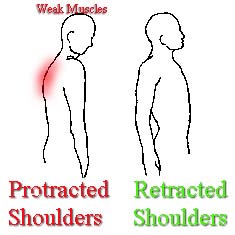 Forward shoulders is another muscle imbalance which causes posture problems which are repercussions of the sedentary lifestyle.
Forward shoulders is another muscle imbalance which causes posture problems which are repercussions of the sedentary lifestyle.
Also called upper-crossed syndrome, forward shoulder posture is prevalent among those who are inactive, especially if your job requires long hours sitting at a desk in front of a computer.
You can also develop forward shoulders posture from poor exercise selection.
If you perform too many pushing exercises (bench press, shoulder press, push-ups) while neglecting your back exercises, or perform pushing exercises improperly, you can develop this muscle imbalance.
The primary muscles responsible for shoulder retraction in the middle upper back (lower and middle trapezius and rhomboids) become lengthened and weak, while the primary muscles on the front which oppose shoulder retraction (pecs and anterior deltoids) become tight.
This is why people who perform too many pushing exercises and not enough pulling exercises tend to develop these posture problems.
To prevent developing or exacerbating forward shoulders posture, it is very important to maintain shoulder retraction during all weight training exercises. Retract your shoulders by pulling your shoulder blades back and down.
Any of these muscle imbalances and their associated posture problems will prevent you from optimally using the targeted muscles during all exercises.
If you suffer from this muscle imbalance and are not able to properly retract your shoulders, you should start a corrective flexibility program.
?♂️ Are There Any Muscle Imbalances Which Are More Prevalent in Men Than Women?
Many muscle imbalances develop because of common daily postures. Since men and women have different mannerisms, certain posture problems are more common in one sex, but may still occur in both.
Three Common Muscle Imbalances and Associated Posture Problems Which Primarily Occur in Either Sex
? Tight Piriformis
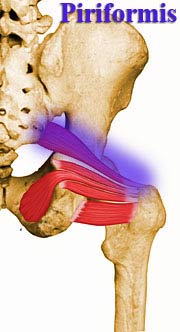
The piriformis is a deep butt muscle which is the most powerful external rotator of the hip. A tight piriformis is more common in men than women because men tend to sit with their legs spread apart.
A tight piriformis can lead to problems with the knees and also piriformis syndrome. Piriformis syndrome is is when the piriformis irritates the sciatic nerve and causes a deep shooting pain from the buttocks down the back of the leg. This is commonly referred to as sciatica.
? Tight Adductors
The adductor complex is the group of muscles which squeeze your thighs together. Since women often sit with crossed legs the adductor muscles commonly develop excessive tension.
Tight adductors can cause the femur (upper leg bone) to become internally rotated. A likely result of this imbalance is knee pain, since the joints of the knee will no longer line up properly.
Tight adductors can be demonstrated by a knock-kneed appearance. This indicator of adductor tightness is especially evident in the bottom of a squat when the hips are almost fully flexed.
? Tight Calves
Women who wear high heels are prone to tight lower leg muscles including the gastrocnemius, soleus, and peroneals. The tightness in these muscles is demonstrated by flattened and externally rotated feet. Tight calves can also be a leading cause in plantar fasciitis and other painful foot and ankle problems.
❓ How Can You Prevent and Fix Bad Posture Due to Muscle Imbalances?
The Most Important Step of Prevention and Correction is Detection
It may be obvious to you if you have pronounced posture problem. If it is not obvious, it is a good idea to see a specialist such as a personal trainer, chiropractor, or qualified exercise physiologist.
There are a several tests which a professional can use to diagnose specific posture problems.
There are telltale signs which a professional such as a personal trainer looks for during functional movements that show your posture problems. You may also be able to observe your own movement in a mirror.
Once you know which of your muscles needs to be strengthened or loosened up you can move on to the next step.
? Getting to the ‘Core’ of the Problem
The muscles which are closest to your body’s center of gravity have to be strong for proper posture and to achieve a fully effective workout. You can not get or maintain a strong core by sitting at a desk all day.
If you perform core exercises regularly and properly, you can teach your body to maintain proper dynamic postural alignment during all of your exercises. You will also improve your static posture.
Since the hip flexors and glutes are at the core of the lumbo-pelvic hip complex, you must have the proper length-tension relationship between them.
In most people, the hip flexors are tight and the glutes are weak. Therefore, strengthening the glutes is also a key aspect of fixing your bad posture.
The very best way to strengthen your glutes is by performing multi-joint leg exercises. You just have to be sure to contract the correct muscle, in this case, the glutes.
? Corrective Flexibility Can Help You Restore Your Body’s Balance
If you have muscles which are chronically tight, corrective flexibility takes a direct approach. Muscles which are tight due to chronic posture such as sitting all day at a desk take time to correct.
Just like weight loss, what happens over weeks, months and even years is not easily reversible. Be patient and diligent, and you will see results with time.
Once you know your correctable structural posture problems, you can follow a corrective flexibility program.
Each corrective flexibility exercise should be specific to your situation. Since this takes time, you should perform these corrective flexibility exercises daily if possible.
❓ What Are Some Corrective Flexibility Techniques to Fix Bad Posture?
The Best Approach to Corrective Flexibility is to Use Multiple Types of Flexibility Training
Here are two different ways in which you can begin to correct your muscle imbalances and posture problems… ?
? Static Stretching
Static stretching is the classic stretching technique you learned from your high school P.E. teacher. You can correct posture problems most efficiently with a combination of SMFR (covered next ?) and static stretching.
Thankfully, static stretching is rather simple! ?
To perform a static stretch, simply hold your body in the stretched position of “slight discomfort” for at least 20 seconds. Perform static stretches many times throughout the day for great results.
? Self-Myofascial Release
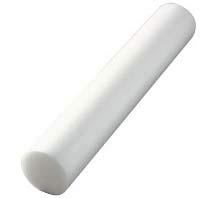 Self-myofascial release (SMFR) sounds a lot more complicated than it is. Myo- is the prefix meaning muscle. Fascia is the tissue which surrounds your muscles.
Self-myofascial release (SMFR) sounds a lot more complicated than it is. Myo- is the prefix meaning muscle. Fascia is the tissue which surrounds your muscles.
Repeated muscular contraction can cause you to develop adhesions or spots of muscle tension. You will be releasing the tension of your muscles by essentially giving yourself a deep tissue massage.
You can get myofascial release from a massage therapist for a high hourly price tag, or you can do it yourself.
The best way to perform self-myofascial release is with a foam roller (shown above), massage ball, medicine ball or even a hard ball such as a tennis or golf ball.
How to perform self-myofascial release using a foam roller… ?
- Place the tight body part on the foam roller. The most important thing to remember is to relax the muscle to which you are applying pressure.
- Apply pressure to the entire length of the muscle with the foam roller. Even though it is just a piece of foam, as you move up and down the muscle you will notice some spots hurt very badly.
- The muscles have accumulated hypertonicity, which you can think of as tension so apply pressure to the most tender spots for 20-30 seconds each.
Key areas to target with your foam roller… ?
- Calves
- Hamstrings
- Glutes
- IT Band
- Quadriceps
- Hip Adductors
- Hip Flexors
- Lats
- Rhomboids
- Triceps
When performing self-myofascial release it may feel like it does nothing for you. If you feel this way, make sure you do it 100% correctly before you abandon it.
Each progressive time you perform SMFR on a muscle, you should notice less tension as the tender spots go away over time. It takes longer for some muscles than others.
You can perform SMFR before or after a workout. You should focus your SMFR on the muscles which are the root of your muscle imbalances and posture problems.
Try performing a session on the foam roller before your static stretching and after.
See Self-Myofascial Release with a Foam Roller for more details.
And here are some foam roller recommendations… ?
- SPRI 36-Inch High Density Foam Roller
- PhysioPhit HD Deep-Tissue Massage Roller
- The Grid 2.0 Revolutionary EVA Foam Roller
? The Benefits of Good Posture: Wrapping it Up
The benefits of good posture are many… ?
✔️ Back relief
✔️ Better digestion
✔️ Improved mood
✔️ Better breathing
✔️ Increased energy
✔️ Improved mobility
✔️ Improved self-confidence
✔️ Improved physical appearance
If you are currently suffering from bad posture and are ready to reap the benefits above and more, you are now armed with some new knowledge to fix things before they get worse.
Utilizing stretching, corrective exercises, and self-myofasical release are just some of the many ways you can correct your posture.
?♂️ Massage therapy is also a great way to relieve muscle tension to get your body back in proper alignment, and it’s something I do regularly.
As someone who has struggled with poor posture for much of my adult life, the best advice I can give you is to fix your posture right away.
Please, learn from my mistakes! ?
More Tips to Fix Bad Posture Due to Muscle Imbalances
Static Stretching
Static stretching is the classic stretching technique you learned from your high school P.E. teacher. You can correct posture problems most efficiently with a combination of SMFR and static stretching. Static stretching is rather simple. Hold your body in the position of “slight discomfort” for at least 20 seconds.
Read the following articles to learn the best stretches for your lower and upper body:
- Leg Stretches
Videos and descriptions of different flexibility and stretching techniques for your legs. Static stretches as well as dynamic and SMFR techniques are covered.
- Upper Body Stretches
Videos and descriptions of flexibility techniques and stretches for your upper body, arms and neck. Learn about dynamic, static, active as well as SMFR stretching techniques for your upper body.
Must-Reads if You Wish to Avoid Posture Problems from Muscle Imbalances
- Hunchback Posture Problems
Some peoples’ poor posture causes them to resemble a hunch back, which in many cases, is just another correctable posture problem caused by muscle imbalances.
- Best Core Exercises to Prevent Postural Imbalance
Optimize your exercise program by learning the best core exercises. The best way to deal with posture problems is to prevent them from happening in the first place. Each core exercise may seem simple, but there are many things you must do correctly to get the most benefit.
- Learn How Personal Trainers Can Help You Correct Muscle Imbalances
Find about how personal trainers can help you as a client, and how you could be helping other people with their posture problems as a personal trainer. Learn why the philosophy used by the National Academy of Sports Medicine works best for most people. Prevent and stop muscle imbalance and posture problems by following the OPT Optimal Performance Training Model.
See Also:
About Theresa Duncan
Originally from Detroit, MI, Theresa has been offering health and fitness advice for the last 30 years while working as an engineer. She decided to turn her passion into a profession, and finds nothing more satisfying than helping others reach their health and fitness goals.

